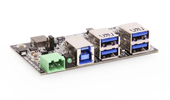As personal computers, laptops, tablets, and other computing devices become more common in work settings, and especially industrial and manufacturing settings, the need to integrate them with legacy devices, hardware, and software, is more and more common.
The Universal Serial Bus, better known as USB, the connection is most common on these more contemporary devices. And it is the number one need in terms of converting communication systems from the past to these devices made in the last several decades that have USB as their only built-in data port. USB converters are incredibly common now and care should be taken when choosing them given the diversity of quality and uses.
RS422 is a common legacy serial communication protocol. Popular for nearly half of the 20th century as a reliable and relatively simple and flexible to implement communication standard, it has survived into the 21st century as a useful and easy to maintain protocol, especially in industrial environments where durable legacy devices continue to function well into a new era dominated by new standards such as USB.
It is more and more common to find PCs that utilize USB ports for running diagnostics or monitoring industrial automation networks and the devices spread out across them. And thus, the need to integrate USB-connective devices with older serial communication-enabled networks is vital for many businesses. The USB to RS422 serial adapter is a commonly used tool as RS422 is very prevalent and serves many industrial uses these days.
RS422: Successor of RS232
The Energy Information Administration’s standard for the RS422 was introduced as a much-welcomed upgrade to RS232 in 1994. Subsequently, the RS485 upgraded and succeeded the RS422 itself. But RS422 is still widely used and effective in many diverse applications.
RS422 and RS422 converters allow one to extend the supported communications distance much farther than RS232 did. Distances of up to 1,200 meters, or approximately 4,000 feet, and speeds of 115 kbps are possible, creating a highly beneficial network tool and protocol that was quickly adopted across industries globally, which has given rise to the current demand for USB to RS422 adapters across many industries.
Long Distances and Resilient Signals
But above all else, RS422 was an improvement over RS232 because it operated reliably, at long distances, under harsh industrial conditions where earthing and grounding variances, and invasive industrial electrical noise could cause significant interruptions in serial communications. This problem had long been an issue for industrial application of RS232 and industrial communications technology in general, and the RS422 upgrade specifically targeted the problem with improved technology.
The twisted-pair wire used for each RS422 converter signal is what allowed this innovation, as they are configured to minimize the effect of induced noise voltages by operating as balanced differential signals. The ability to operate without interruptions in electrically noisy industrial environments ensured that RS422 would become a staple of industrial communications.
Multi-Drop Networks
Additionally, RS232 was originally engineered as a point-to-point, singled-ended, connection maker. When they are used for multiple devices, one has to create a daisy chain of devices, which would be susceptible to downstream failure if one cable break occurred between slave nodes: communication would then become impossible for all downstream nodes and devices, causing potentially painstaking interruptions in manufacturing and communications. RS422 addressed this issue. It has the advantage over RS232 of being able to better support multi-drop networks.
For the EIA’s RS422 protocol, a multi-drop network is an interface with one driver and a number of multiple receivers connected on the same interface. This bus network topology is better served by RS422 because the specification allows up to ten slave receiver nodes to connect via the multi-drop configuration. Significantly, these will have the feature of different paths for transmitting and receiving, removing the potential failure that a daisy chain configuration is susceptible to.
For servicing devices in the field, for example, a data logger, notebook computers are commonly used by an engineer now. The computer or tablet will likely have several built-in USB ports. This is one of the most common points where you may find USB to RS422 converters being utilized with great convenience as well.
Many of these converters are configured as hubs, with some of Coolgear’s supporting up to 8 ports. Models may often support other protocols (RS422 and RS495). High quality converters have many specifications that you may want to discuss with a Coolgear specialist. Please reach out to us if you are interested in our products or just need some help understanding your needs.




















